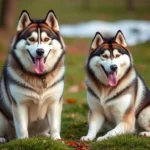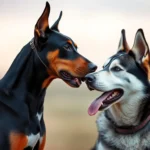
Introduction
Dog breeds showcase a remarkable diversity, reflecting thousands of years of evolution and selective breeding. Among them, the pug stands out as a particularly unique breed, loved for its charming personality and distinctive features. One of the most recognizable traits of the pug is its curly tail, a feature that raises the question: why do pugs have curly tails? Understanding the significance of this characteristic involves exploring genetics, breed standards, and the historical context of the pug breed.
Understanding Dog Breeds
Definition of Dog Breeds
A dog breed is a specific group of domestic dogs with particular characteristics, behaviors, and physical traits that distinguish them from other groups. Breeds are classified as either purebreds, which have a documented lineage, or mixed breeds, which result from the interbreeding of two or more breeds. Each breed has its own set of standards that define its ideal traits, including size, coat type, and temperament.
Importance of Breeds
The characteristics of a breed play a crucial role in shaping a dog’s behavior and care needs. For instance, working breeds like the German Shepherd are often energetic and need regular exercise, while toy breeds like the Chihuahua may require less physical activity. Over time, breeds have been developed for specific tasks, such as herding, guarding, or companionship, which has influenced their behaviors and care requirements.
The Pug: A Brief History
Origin of the Pug
The pug has a rich history that dates back to ancient China, where it was revered as a companion animal for royalty. Pugs were bred to be small, affectionate dogs that could fit comfortably in the laps of emperors and their families. The breed eventually spread to Europe in the 16th century, where it became popular among nobility, further solidifying its status as a beloved companion.
Breed Standard and Characteristics
Pugs are characterized by their compact, muscular bodies, short legs, and distinctive wrinkled faces. They typically weigh between 14 to 18 pounds and stand about 10 to 14 inches tall at the shoulder. Pugs come in various colors, including fawn, black, and silver. Their temperament is generally sociable, playful, and affectionate, making them excellent family pets.
Anatomy of Pugs
Unique Physical Features
In addition to their curly tails, pugs have several distinctive physical features that contribute to their charm. Their flat faces lead to a brachycephalic structure, giving them a unique appearance but also resulting in breathing challenges. Their short legs and sturdy build create a lovable, squishy look that endears them to many dog lovers.
The Curly Tail
The curly tail of the pug is one of its most defining features. Unlike straight tails, a pug’s tail curls tightly over its back, giving it a playful and whimsical look. This tail structure not only adds to their charm but is also a topic of interest among dog enthusiasts. In comparison, other breeds like the Basenji and Akita also have curly tails, but the pug’s tail is distinctive in its tightness and position.
Why Do Pugs Have Curly Tails?
Genetic Background
The reason why pugs have curly tails lies in their genetics. The curly tail trait is a result of specific genetic variations that affect tail structure during development. Selective breeding has reinforced this characteristic, as breeders favored pugs with the most visually appealing tails. The gene responsible for the curly tail is dominant, meaning that even if only one parent carries the gene, their offspring are likely to inherit the trait.
Functional Purpose of the Curly Tail
While the curly tail may seem purely aesthetic, it has potential functional purposes. In some dog breeds, tails serve as a means of communication, helping to express emotions. For pugs, their curly tails may enhance balance and agility as they navigate their environment, although this is not as pronounced as in working breeds. Historically, curly tails may have played a role in the pug’s ancestry, aiding in communication among pack members.
Cultural Significance
The curly tail of the pug has also found its way into cultural representations, appearing in various artworks and media. In Chinese culture, where pugs originate, the curly tail symbolizes happiness and good fortune. Their playful nature and unique appearance have made them popular subjects in art, contributing to their reputation as joyful companions.
Health Considerations Related to Curly Tails
Common Health Issues in Pugs
While pugs are adored for their unique features, certain health issues are prevalent in the breed. Their brachycephalic nature can lead to breathing difficulties known as Brachycephalic Obstructive Airway Syndrome (BOAS). Additionally, pugs may experience skin problems, obesity, and eye issues due to their prominent eyes. Specific to their curly tails, some pugs may develop tail fold dermatitis, a condition caused by moisture and debris accumulation in the tail’s curl.
Best Practices for Care
To ensure the health of their curly tails, pug owners should adopt best practices for care. Regular grooming is essential to keep the tail area clean and free of irritants. Bathing and cleaning the folds around the tail can prevent skin issues. Furthermore, routine veterinary check-ups are crucial for monitoring overall health and addressing any concerns related to their unique anatomy.
Other Dog Breeds with Curly Tails
Overview of Breeds with Similar Traits
Several dog breeds share the characteristic of curly tails. Some of these include:
- Basenji: Known as the “barkless dog,” it has a tightly curled tail and a keen hunting instinct.
- Akita: A large breed with a thick, curled tail, renowned for its loyalty and protective nature.
- Shiba Inu: This breed features a curled tail that adds to its fox-like appearance.
Differences and Similarities
While breeds like the Basenji and Akita have curly tails, the structure and function can vary. For example, the Basenji’s tail is less tightly curled compared to the pug, and it typically has a more athletic build. The differences in tail structure can impact the dog’s movement and balance, showcasing the diversity within dog breeds.
Conclusion
The significance of the pug’s curly tail extends beyond mere aesthetics; it is rooted in genetics, historical context, and cultural meaning. Understanding why pugs have curly tails helps appreciate the unique characteristics of this beloved breed. Each dog breed brings its own set of traits and quirks that make them special, and appreciating these attributes is essential for responsible ownership and care.
FAQs
Common Questions About Pugs and Their Tails
Why do pugs have curly tails?
Pugs have curly tails due to specific genetic traits that have been reinforced through selective breeding.
Is the curly tail of a pug a health concern?
While the curly tail itself is not a health concern, it can lead to tail fold dermatitis if not properly maintained.
General Dog Breed Queries
Are all dog breeds prone to specific health issues?
Yes, many dog breeds have predispositions to certain health conditions due to their genetic makeup and physical characteristics.
How can I ensure my dog lives a healthy life?
Regular veterinary check-ups, a balanced diet, and adequate exercise are essential for maintaining your dog’s health.









